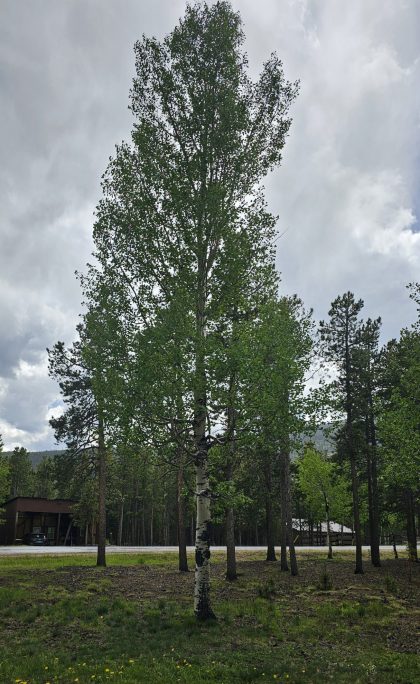Beltane and the Shadow Mountain Moon
This is the first entry in my honoring the Tree mussar practice. I will post these as I do them.
My kavanah, my intention, is to enhance my capacity for honoring all things, all Earthlings. Including humans. In this honoring means paying attention, close and uninterrupted attention. Seeing the other for what they exhibit, to imbibe their uniqueness and their interconnectedness. This uniqueness has many names: Buddah nature, soul, highest potential, essence, wholeness, image of God. In seeing the sacred reality of this Aspen I am in turn seeing my own sacredness in the process of seeing the Aspen.
When we first moved here on the Winter Solstice of 2014, this Aspen had no leaves. Tiny shoots of its clones were hidden beneath the Snow cover. But they were there.
Nine and a half years later I went out today, out front since this Tree is in the front. As I walked up to it, I noticed its Trunk’s variation between a smooth gray Bark and a wrinkled black Bark. As if the Tree could not make up its mind. I’m curious now as to the purpose of the two different types of Bark. A Spider and an Ant crawled over both smooth and rough, unconcerned.
My hand found the change in textures though they seemed more graduated with touch. The smooth Bark had some grippiness to it and also contained small raised bumps of the rougher black Bark. When I walked around the Tree, I noticed at its base a large scar, black Bark that looked like a Fire scar. Doesn’t make sense to me, but it’s a distinctive feature of this Tree and a reminder that its journey has not always been easy.
Looking straight up the Trunk toward the Leader reaching for the Sky the Bark got smoother and smoother as it went up and the Trunk got smaller. Could it be that a certain girt stretches the smooth Bark far enough that it separates and allows the rougher Bark to form? If so, why?
The most striking feature of this tree for me, on this sunny Colorado Mountain morning, danced on the ends of short stems, quaking this way and that. Throwing shadows on the Leaves behind them, then fluttering out of the way. Leaves in groups of five opened and closed each others access to Great Sol’s brilliance.
The interplay of light and shadow these Leaves put on would make a great Calder sculpture. The shifting moving Leaves were beautiful. As beautiful as any work of art in a museum.
While being beautiful, they also perform Mother Earth’s true miracle, light-eating. Turning photons into sugars. The sine qua non for all complex life on this planet.


